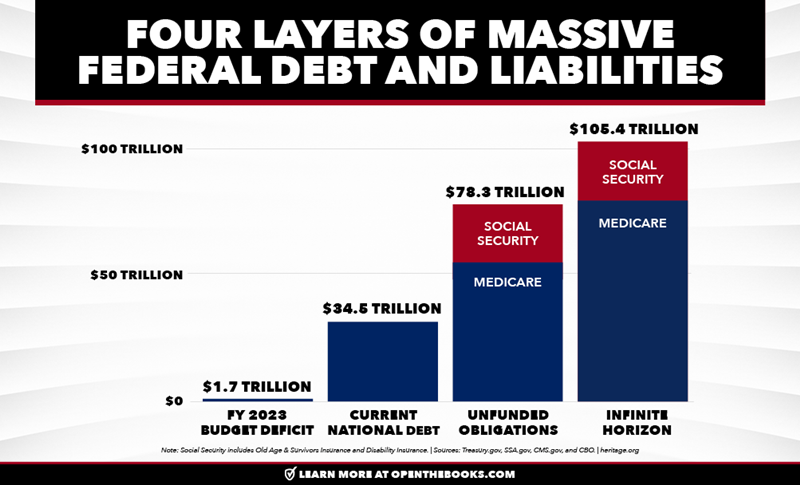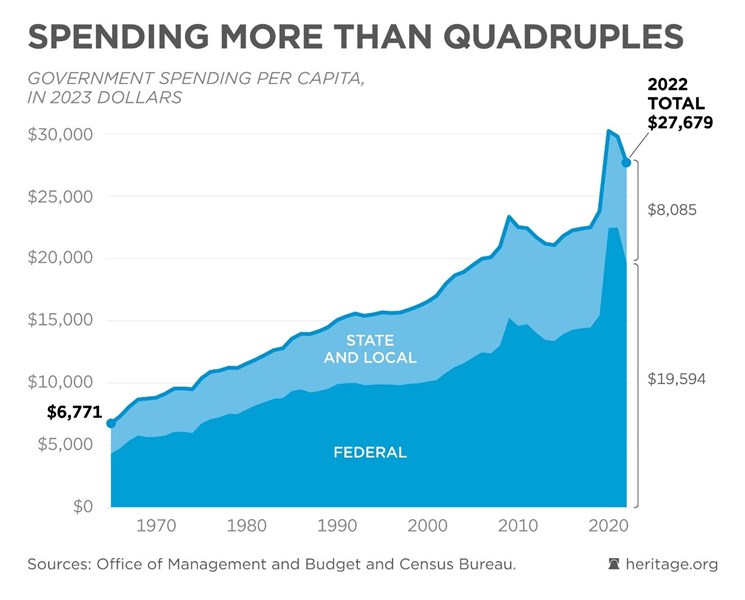

By Adam Andrzejewski | Published at Substack
Topline
$175,300,000,000,000 is the most important financial number in the world.
The new Financial Report of the United States Government (February 2024) estimates that the financial position of Social Security and Medicare are under funded by that much. Treasury Secretary Janet Yellin signed the report.
The amount is unfathomable. Here are two examples for context:
The Federal Government has been paralyzed. The last reform worthy of the name was 41 years ago next month.
So, Medicare is forecasted to start cutting benefits in just seven years. Social Security’s trust funds start running out of money in ten years. The funds are projected for depletion by 2041.
In 2013, then-U.S. Senator, the late Dr. Tom Coburn, warned that Congress was “drunk on spending.” Coburn highlighted the federal unfunded liabilities, which then were $128 trillion. Today, just ten years later, the financial picture is considerably worse – up nearly $50 trillion, or 39 percent!
Because of the size of the deficit, there is no clear path towards obtaining the funding needed. that means radical changes could be coming to two of the nation’s most fundamental services.
75-year Projections
The Treasury estimates that the U.S. will spend $215.7 trillion in the next 75 years to give Social Security and Medicare payouts to beneficiaries. In that period, collections – mostly through payroll taxes – are estimated at only $137.4 trillion.
The $78.3 trillion funding gap? According to the Yellin Report, it can only be generated through increased borrowing, higher taxes, reduced benefits, or some combination of these. All options are politically toxic, which is why Congress is hiding, hoping the problem will go away. And why no one in Washington DC wants to talk about the Yellin Report.
For example, more than half of the unfunded liability comes from Part B of Medicare, which covers “basic healthcare services” like doctor’s visits and equipment such as wheelchairs.
The “Infinite Horizon” Projection
It gets worse: the Yellin Report honestly tells us that the 75-year projection underestimates just how much extra cash is needed because that period does not include the years when most Social Security and Medicare dollars will be paid out.
Think about it. A child born today will pay massivef taxes into Medicare and Social Security over the next 75 years. But the government will not have to send that person benefit checks until they are 62 years old, meaning the majority of payouts will occur more than 75 years from now.
Since this “infinite horizon” model covers an individual’s entire life, this model exposes even more funding gaps.
The Treasury estimates that current participants will use $105.4 trillion more from Medicare and Social Security than those same people pay into the programs through taxes.
“Future” participants, who are now younger than fifteen or even still in the womb, will use $69.9 trillion more than they contribute.
Combined, that is an absurd $175.3 trillion gap that Congress has been ignoring.
Here are how the unfunded liabilities break out by program:
-
Medicare Part A, which covers hospital visits, is projected to have $15.1 trillion more than it needs.
-
Medicare Part B is the largest liability with an unfunded $99.5 trillion.
-
Medicare Part D, for prescription drugs, will be missing $22.1 trillion.
-
Social Security needs an additional $68.8 trillion.
Background
Medicare and Social Security are supposed to be self-sustaining. We fund them in three ways: payroll taxes, premium payments on Medicare plans, and taxes on large Social Security payouts.
From inception to the 1970s, the program ran like it was intended. Revenues fully covered the cost of the programs – and then some. But President Ronald Reagan and Speaker Thomas P. “Tip” O’Neill, in the 1980s, saw the imbalances coming.
A bi-partisan commission was established, which built a set of real reforms, which passed Congress and the President signed into law. The Social Security Reform Act of 1983 made “comprehensive changes in… coverage, financing, and benefit structure,” according to the Treasury.
However, even then, all experts knew another round of reforms would be necessary.
But the leadership we saw in the 1980s simply has not returned, and the crisis has grown. Medicare spent $446 billion more than it collected and Social Security was upside-down $88.8 billion last year (2023).
Spending will only increase. Medicare equaled 2.9% of the nation’s GDP in 2022, but the Congressional Budget Office estimates it will be 5.9% by 2052. Social Security will rise to 6.4% from 4.9%.
U.S. law sets a flat rate of money that the government must provide for Social Security and Medicare each year. It requires the Treasury to borrow money if there is not enough available. That provision alone could cause issues in the not-so-distant future.
Some Reasonable Bipartisan Reforms
Here are some reasonable reforms that statesmen in both parties could embrace:
1. Mistaken and improper payments: Each year Medicare and Medicaid admit to approximately $130 to $140 billion in mistakes – payments in the wrong amount, to the wrong person, or under the wrong set of rules. Overall, the Biden Administration is on track to misallocate nearly $1 trillion in admitted mistakes across the twenty largest federal programs during his four-year term. Fix it!
2. Fix Immigration: Eight million illegal entrants crashed our borders during the previous three years, and no one knows if each migrant is a lifetime net cost or benefit to our system. America needs an ordered immigration system where we welcome smart, hardworking, entrepreneurial, and legal immigrants – to spur economic growth and spread our debts.
3. Grandfather benefits and then cap them for everyone else. If you are paying taxes into the system, you are in. Everyone else coming down the pike gets a different plan.
Together, we can make the system sustainable and give our children and grandchildren a proper soft social safety net for their retirement years.

Additional Reading
Medicare And Social Security Face $175 Trillion Shortfall Risking Future Generations | The National Desk, Sinclair Broadcast interview | March 1, 2024
Medicare And Social Security Are Both In Crisis As Underfunding Hits $175 TRILLION | The Daily Mail | March 2, 2024
Our National Debt Is Our Biggest National Security Threat | by Adam Andrzejewski | OpenTheBooks.Substack | August 23, 2023
Federal Agencies Admit To $3 Trillion In Improper Payments Since 2004 | by Adam Andrzejewski | OpenTheBooks.Substack | June 13, 2023
U.S. Debt Clock |usdebtclock.org